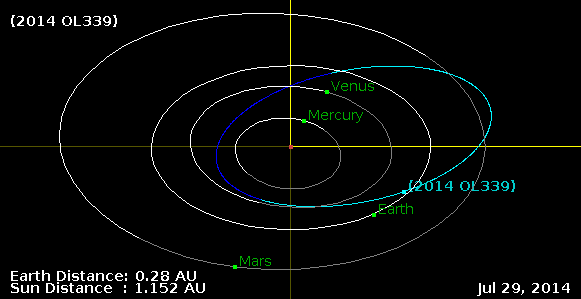
Astronomers have discovered an asteroid called 2014 OL339, that is the latest quasi-satellite of Earth – a space rock that orbits the sun but is close enough to Earth to look like a companion.
Our planet has one permanently bound satellite - the Moon, but also a likely large number of mini-moons or transient irregular natural satellites, and temporary natural retrograde satellites or quasi-satellites.
The newest addition to the family of Earth’s quasi-moons was discovered on July 29, 2014 by Farid Char of the Chilean University of Antofagasta. As of September 2014, it has been observed 27 times with an observation arc of 36 days. With an absolute magnitude of 22.6 and highly elliptical, quite chaotic orbit, it has a diameter in the range 90–200 meters. Its present co-orbital episode started at least 775 years ago and it will end 165 years from now, with an approximate duration of 1,000 years.
In a recently published paper, C. de la Fuente Marcos and R. de la Fuente Marcos of the Complutense University of Madrid in Spain, try to predict the evolution of the chaotic orbit of 2014 OL339.
“The past and future orbital evolution of this object becomes difficult to predict although it remains in the neighbourhood of Earth’s co-orbital region for thousands of years,” the researchers write. “Asteroid 2014 OL339 was considerably more stable in the past. It may remain as a co-orbital to our planet switching between the various co-orbital states.”
Its dynamical status is temporary and it is not expected to last more than 1000 to 2000 years as this object is one of the most unstable known Earth quasi-satellites.
Quasi-satellites orbit in resonance with Earth, allowing the planet's gravity to shift the rock's position much like an adult pushing a child on a swing, said Martin Connors, an astronomer at Athabasca University in Canada. The asteroid orbits the sun every 365 days, as Earth does, but Earth's gravity guides it into an eccentric wobble, which causes the rock to appear to circle backward around the planet.
Most planets and even some large asteroids are accompanied by hangers-on. With four quasi-satellites catalogued so far, Earth comes in second only to Jupiter's six, though the gas giant probably has many more that we can't see. The same is probably true of Earth, as small space rocks are difficult to find – astronomers didn't spot the first till 2004.
"If you go into your kitchen and you see some big cockroaches, you know there are a lot of little ones there, too," Connors said.
So far, Jupiter has the largest number of documented quasi-satellites with at least six, including asteroids and comets. Our planet comes in second place with four detected quasi-satellite companions: (164207) 2004 GU9, (277810) 2006 FV35, 2013 LX28 and now also 2014 OL339.






Comments